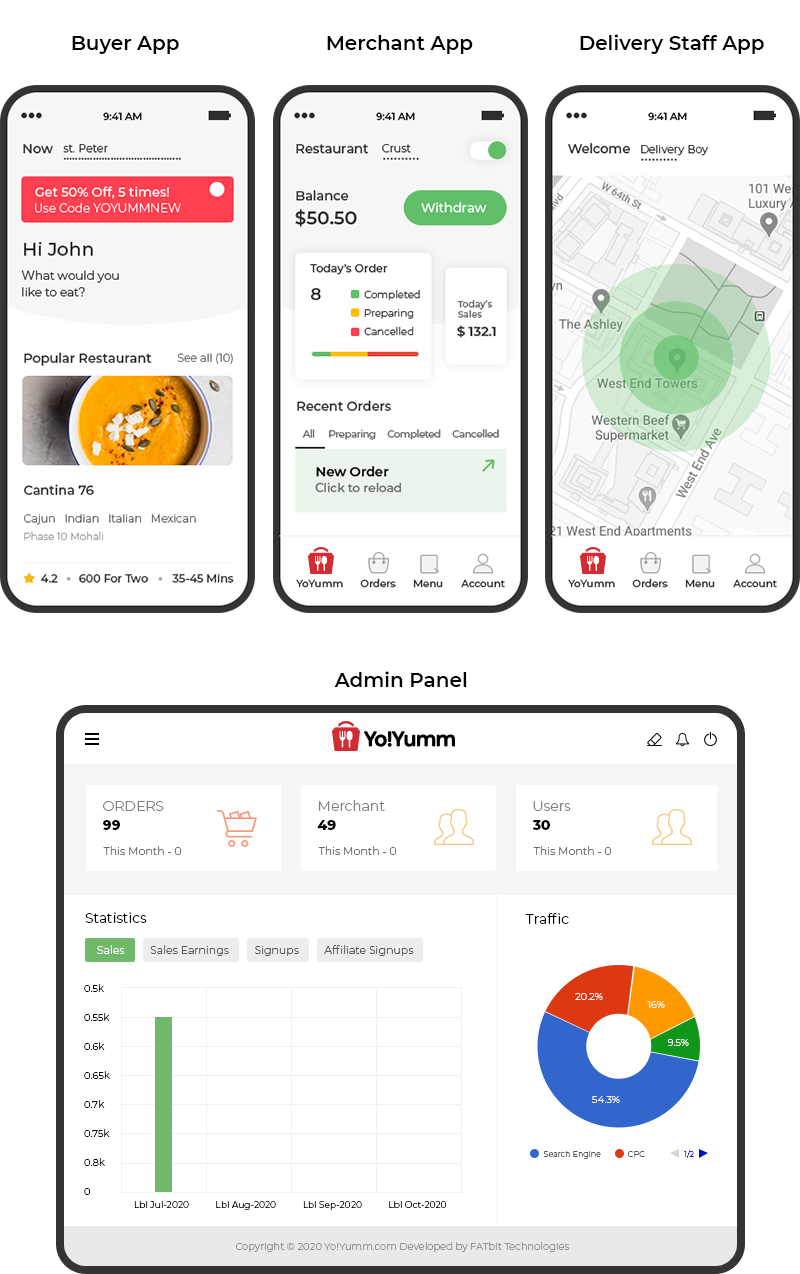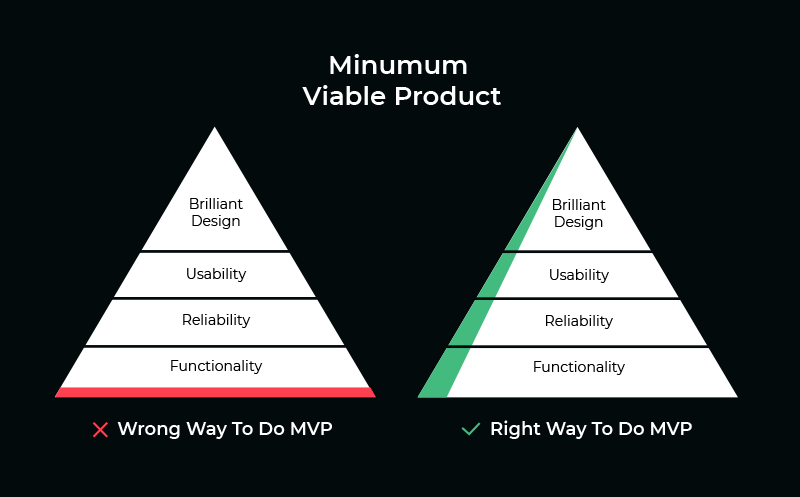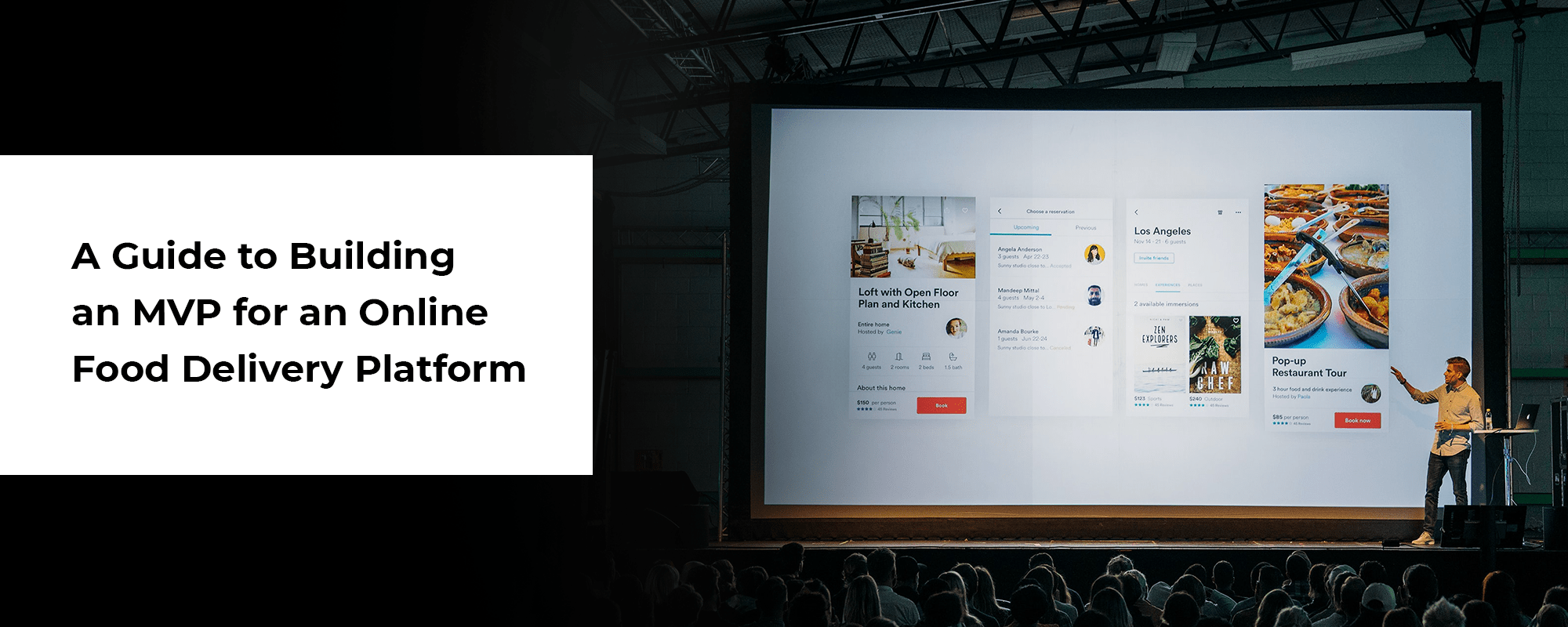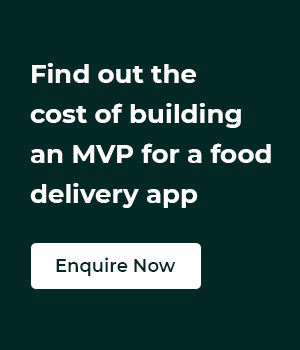The introduction of an on-demand food delivery system has redefined customer satisfaction. The trend of on-demand delivery is not just confined to the food industry but has spread out almost the entire e-commerce industry.
When working in an on-demand economy the idea is everything and spending a substantial amount of money only to find out there is no market appeal to the idea can be a huge loss. A food delivery marketplace with MVP Solution can help you avoid all that. In this blog on MVP development for the delivery marketplace, let us begin by understanding how to build an MVP along with various learning and optimizations along with the process.
How To Build MVP for Online Food Delivery Marketplace
A Minimum Viable Product is the version of a product, with essential launchable features. It is the earliest feasible solution with the main aim to validate the assumptions and the idea related to the food delivery business, along with attracting early adopters in the early stages of the product development cycle. A series of steps are involved in the launching of an MVP for a food delivery marketplace.
Test a Hypothesis for Online Food Delivery MVP
The process of building an MVP is whittling your way through various ideas, till the best of them eventually works out. It is advisable to consider a Riskiest Assumption test(RAT) before getting on board with your idea of building an MVP.
The purpose of RAT is to test the ideas and hypotheses related to the development of MVP. The fundamental goal is to collect the feedback of customers as quickly as possible and check whether the idea of the product is feasible or not. A step-by-step approach to test a hypothesis for an online food delivery app is given below.
Formulation of ideas to solve customer problems
There is a huge difference between finding an appropriate solution to a customer problem and fitting a problem to an already formulated solution. When dealing with an MVP related to food delivery, customers may have issues related to timely delivery, order tracking, easy registration, and many more.
Use the 5-whys model to dig deeper into your customer’s expectations and identify the pain points to find a suitable answer to their queries. The main aim of this technique is to narrow down the source of the problem by recurring the question “Why?”
The basic idea would include:
- The customer(buyer) app
- The delivery staff app
- The admin panel
- Merchant app

Identifying assumptions and finding the riskiest one
There are several assumptions related to a new product. While designing and testing an MVP, all these assumptions are listed and are whittled as per their feasibility in the current scenario. A few instances of many possible assumptions when building food delivery software are as follows:
- There is unlimited availability of food during working hours of the restaurant, no inventory management is required.
- Restaurants onboard do not have their delivery fleet, and will solely be dependent on the food delivery marketplace software.
- Customers will be able to view and receive delivery from restaurants within a particular radius.
- Ordering from a single restaurant at a time is allowed to the customer.
A new idea always accompanies observation and intuition, which when validated in a controlled experimental atmosphere becomes the basis of a new finding or development. Once all the assumptions are listed the next step would be to find the one that would hinder the food delivery business the most.
Build a Hypothesis
To build a hypothesis, an assumption needs to be validated through a set of real-time scenarios. A hypothesis is a statement that will be true only if the assumption it is based on, holds. In the case of a food delivery app, if the assumptions hold, the hypothesis states that certain requirements given below must be met.
Functional Requirements
A Customer should be able to:
- Search for restaurants
- Items to cart
- Place order
- Receive Notifications
- Track the order status
- Cancel the order
- Make payment for the order
- Update profile.
A restaurant should be able to:
- Create, edit and delete profile
- Create and edit menu
- Send and receive notifications
- Update order status
Delivery Rider should be able to
- Create, edit and delete profile
- Send and receive notifications to restaurant and customer
- Track the order for pickup and delivery
- Notify issues if any
A few other requirements that should hold for hypotheses related to an MVP for a food ordering/delivery app are consistency, latency, availability, and so on.
Testing a hypothesis
A hypothesis for an MVP for a food delivery app may fall under three categories:
- Proven insignificant.
- Completely significant and as per customer needs.
- Falls somewhere in between the above two categories.
If most of the ideas fall under the third category, we can perform a cost-benefit analysis, and consider the case where the benefit exceeds the cost.
Build an MVP for your Online Food Delivery Marketplace
Learnings During the Development and Benefits of Food Ordering MVP
MVP, as per Eric Ries, the author of “ The Lean Startup” allows a collection of the largest amount of validated learning about customers with minimal effort.

The process of MVP development in itself is very informative and gives way to many learnings as below:
Sticking to the core
Most of the product owners tend to focus on secondary functionalities of the product, losing focus on the main functionality, MVP helps stay clear of such deviation and provides a perspicuous vision of the product functionalities.
Less cluttered interface
Keeping the focus on essential features gives a less cluttered space and lesser complications in software usage. Every feature can be easily tested and investigated for better enhancement of the MVP of the food ordering/delivery app.
Minimized risks
The most important aspect to be kept in mind while crafting a software product is that all polished large-scale apps require a lot of money and effort and take years to build. Almost every popular software product started as an MVP and gradually all the extensive features were adopted.
The MVP approach has several benefits including clarity of vision, quicker release, and many more. A few of the benefits are discussed below:
Clarity of Vision
Having a clear idea of the product’s final version is very helpful eventually. The entire team should be thorough with the basic functionalities and the journey of the product from its primary version to the culminating one.
An early connection with customers
It gives the advantage to connect with your customers at the initial development stages of the product. Early adopters will give invaluable feedback about your food delivery app and influence potential customers. Timely weighing up the customers results in effective development and better understanding.
Quicker release
An MVP allows the product owner to launch a product at a rapid pace. As the product has all the basic and essential functionalities, it is in itself a complete and workable version of the main product. An accelerated time–to–market allows the business owner to entice early adopters, enabling them to test the hypothesis on the first version of the product. Through a series of iterations as the product scales up it helps in gaining a loyal customer base.
Optimization of Hours Exhausted During Iterative Development
As we progress in the article, the next step is to deploy our learnings and experience achieved to optimize the time required to build the MVP without trading off the product quality. It can be very overwhelming to perpetuate equilibrium in the task loads and tight deadlines.
This part of the article enlightens the developers with the ways they can achieve optimization which in turn will help the business owner in economizing during the MVP development process. The article further provides a list of certain factors that can be of assistance in accelerating the development process.
Step 1: Division into small teams
The idea here is to project by cleaving a colossal piece of work into small manageable portions and allotting small teams to handle the tasks. This way we can accomplish the company goals in a quick and optimized manner.
Step 2: Clarify requirements and build a road map
Planning a task by creating a road map will minimize the span required to plan the next task time and again along with reducing the risk of failure.
Step 3: Set limits to Work in Progress(WIP)
Too many tasks can be overwhelming and can hamper the productivity of the MVP development. The best way is to use the kanban board to manage the development process and to maximize the number of tasks in the list.
Step 4: Focus on actual requirements
Focusing on the work that truly counts will save a hefty amount of time. To increase the efficiency of your team it is better to build the software in small chunks and emphasize user feedback.
Step 5: Technical debt
It might seem that you have speeded up the process but in actuality, technical debts swell the complexity of the system.
Step 6: Automation
Try using automation tools to ease down your developers. Some of the areas where automation can be rewarding are testing, CI/CD pipeline(Continuous Integration/Continuous Delivery), and other workflow automation tools.
The methods discussed above can help in speeding up the development process by optimizing the time dedicated to it. Moving forward, let’s weigh up certain factors on which the duration of the development process relies.
Factors affecting the duration of the development process
The methods discussed above can help in speeding up the development process by optimizing the time dedicated to it. Moving forward, let’s weigh up certain factors on which the duration of the development process relies.
Quality of the code
The quality of any work is directly proportional to the time dedicated to it. There is no circumvent to excellence. Cutting the corners will eventually give rise to many errors which will again require a lot of time to be fixed before you can deliver a fully functional code.
Size of the team
As discussed earlier, a small team will boost the internal communication of the team members. The team size from 4 to 8 is considered to be ideal for most collaborative teams.
Complexities of the development process.
The various challenges faced by the development team may cost the company in terms of hours. These include the time associated with unreasonable deadlines, unclear project requirements and objectives, internet issues, and structural deviations.
Human resources
The skill, experience, and motivation of each team member count. It can take some time for an employee to onboard with the system and eventually flourish to become the biggest asset for the company.
An MVP to support your ideas for an Online Food Delivery Marketplace
Early Adopters for your Online Food Delivery Marketplace
Early adopters are the first customers of the product. They are often referred to as the lighthouse customers, as they act as a beacon of light, giving direction to the other customers to follow. They try new products before other consumers and provide feedback to assist them in the refinement of features, design, and distribution.
Firstly, let’s find out why early adopters buy at early stages as this will help the business owner to understand his first audience and help him entice them, further allowing him to scale up his business.
Adventurous nature
They are people who like taking risks by buying a new product as they want to stand out from the crowd. Their feedback helps other customers make wise decisions regarding the product.
Instinctive
Early adopters can judge the book by its cover and tell if the product has a future. Their instinct relies on years of product usage and technical knowledge gained with experience.
Exhibit fear of missing out (FOMO)
They usually comprise young people who don’t want to be the last ones trying out a new food delivery platform or any other product. Being social influencers they become a huge asset for a company’s success.
Tips and techniques for food delivery startups to cater to the early adopters
Moving further let’s discuss a few techniques food delivery startups should follow to give their early adopters the best experience of your product.
- Making special deliveries
A new customer, especially an early adopter is special for the company. To make the customer feel exceptional, special deliveries can be attempted. Special discounts are common, but if someone from the founders’ circle would make delivery, the impact would be phenomenal.
The quality of food delivered is very important. The delivery personnel should carry the food with utmost care giving customers freshly cooked food in proper packaging. Add small sample packets of other food products for advertising your best-selling food items.
The basic intent of a customer ordering food online is receiving timely delivery of packaged food. For a startup, it is an opportunity to find its way into the good books of the customer.
A few other techniques may include a thank you note addressing the customer and lastly, a small surprise would be an ever-lasting memory for the company as well as the customer.
Brand Building and Establishing the Online Food Business
For boosting your brand recognition and creating a cohesive and consistent brand name, strategize a marketing plan that stands out.
Marketing strategy for food delivery marketplace
- Creates a comfortable experience for your customers so that they can easily navigate through your website and place their orders.
- Make ordering, tracking, and receiving deliveries convenient by linking a third-party application to your mobile application.
- List yourself on Google My Business to boost your business.
- Promote your brand name on social media platforms by linking your website to profiles like Facebook and LinkedIn.
- Boot your food delivery marketplace MVP using significant tools like location-based Google advertisement and local SEO.
Conclusion
Lastly, to sum up, MVP for a food delivery marketplace is a product with minimum investment and features, although it is focused on providing a viable solution. It becomes the basic foundation on which iterations are run to deliver measurable outcomes for your food delivery marketplace. A hypothesis-driven approach to achieve a phased business value can only work when an MVP is designed in alignment with the business initiative along with gaining an insight into the riskiest assumptions.
Optimization of working hours and building a good image for your early adopters are important measures for scaling up your business using an MVP food ordering/delivery app. It can be concluded that an MVP allows a product owner to decide whether or not they are ready for scaling up their business.




